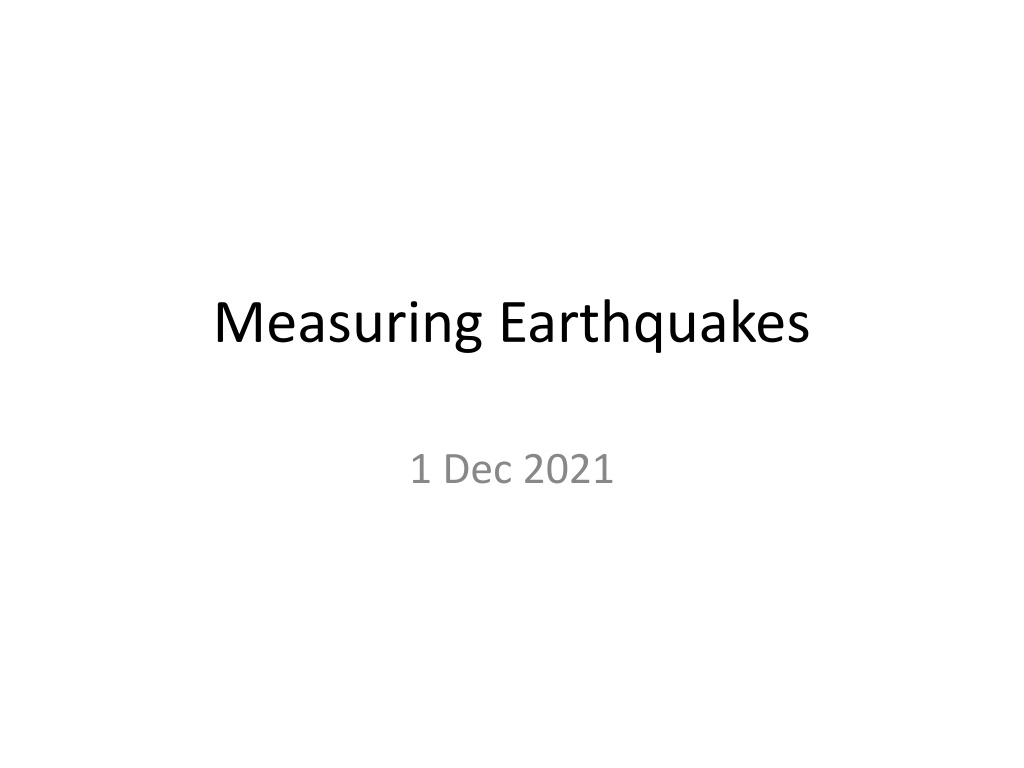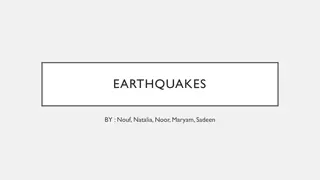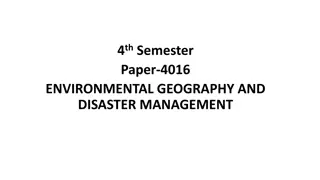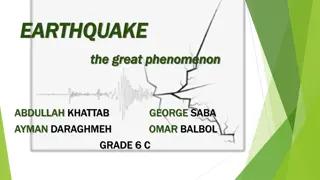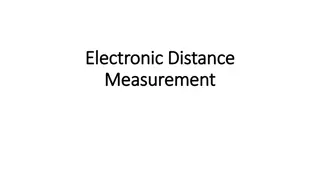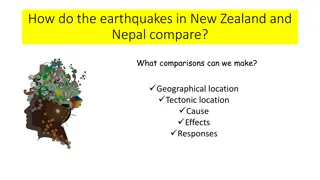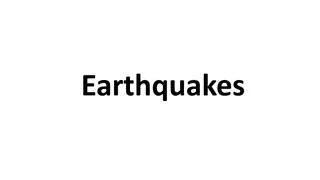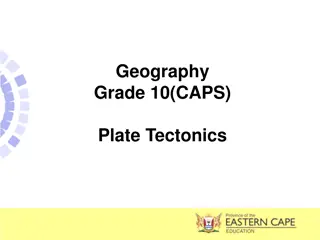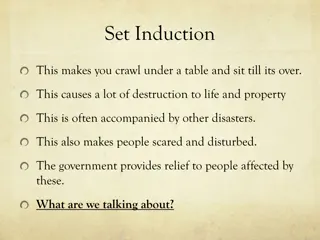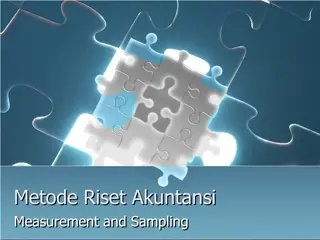Understanding Earthquakes: Measurement and Impact
Explore the different ways earthquakes are measured, such as the Richter and Mercalli scales, and learn about the levels of intensity and impact on people and structures. Discover how seismographs help in recording earthquake vibrations and understand seismic waves and the shadow zone in Earth's structure.
Download Presentation

Please find below an Image/Link to download the presentation.
The content on the website is provided AS IS for your information and personal use only. It may not be sold, licensed, or shared on other websites without obtaining consent from the author. Download presentation by click this link. If you encounter any issues during the download, it is possible that the publisher has removed the file from their server.
E N D
Presentation Transcript
Measuring Earthquakes 1 Dec 2021
Do Now What is an earthquake? How many seconds are in a minute? 4 minutes 30 seconds minus 2 minutes 40 seconds is? Shaking of earth 60 1 minute 50 seconds
Shadow Zone Area that receives no seismic waves S-Waves are absorbed at the liquid outer core 104 140 P-Waves are refracted or bent at the boundary between the outer core and mantle
Waves move energy not matter
Measuring Earthquakes There are two ways to measure earthquakes Richter scale Mercalli scale Mercalli scale measures the intensity - its effect on people Mercalli scale does not measure the energy released Mercalli scale is subjective
The following is an abbreviated description of the levels of Modified Mercalli intensity. Intensity I II III Many people do not recognize it as an earthquake. Standing motor cars may rock slightly. Vibrations similar to the passing of a truck. Duration estimated. IV Light Felt indoors by many, outdoors by few during the day. At night, some awakened. Dishes, windows, doors disturbed; walls make cracking sound. Sensation like heavy truck striking building. Standing motor cars rocked noticeably. V Moderate Felt by nearly everyone; many awakened. Some dishes, windows broken. Unstable objects overturned. Pendulum clocks may stop. VI Strong Felt by all, many frightened. Some heavy furniture moved; a few instances of fallen plaster. Damage slight. VII Very strong Damage negligible in buildings of good design and construction; slight to moderate in well-built ordinary structures; considerable damage in poorly built or badly designed structures; some chimneys broken. VIII Severe Damage slight in specially designed structures; considerable damage in ordinary substantial buildings with partial collapse. Damage great in poorly built structures. Fall of chimneys, factory stacks, columns, monuments, walls. Heavy furniture overturned. IX Violent Damage considerable in specially designed structures; well-designed frame structures thrown out of plumb. Damage great in substantial buildings, with partial collapse. Buildings shifted off foundations. X Extreme Some well-built wooden structures destroyed; most masonry and frame structures destroyed with foundations. Rails bent. Shaking Not felt except by a very few under especially favorable conditions. Felto nly by a few persons at rest,especially on upper floors of buildings. Felt quite noticeably by persons indoors, especially on upper floors of buildings. Description/Damage Not felt Weak Weak
Richter Scale Seismographs are instruments used to measure the vibration in the earth Richter scale measures the amount of energy released Each increase in number is an increase by the power of ten Wide spread use of seismographs allow measurements of magnitude Nuclear Test ban treaty About 700 seismic stations in 1960
Largest earthquake 1960 Chile: magnitude 9.5 1655 killed
. Intensity (Mercalli) Observations (Mercalli) Magnitude (approx. comparison) I No effect II Noticed only by sensitive people III Resembles vibrations caused by heavy traffic IV Felt by people walking; rocking of free standing objects V Sleepers awakened; bells ring VI Trees sway, some damage from falling objects VII General alarm, cracking of walls VIII Chimneys fall and some damage to building IX Ground crack, houses begin to collapse, pipes break X Ground badly cracked, many buildings destroyed. Some landslides XI Few buildings remain standing, bridges destroyed. XII Total destruction; objects thrown in air, shaking and distortion of ground Richter Scale 1 to 2 2 to 3 3 to 4 4 4 to 5 5 to 6 6 6 to 7 7 7 to 8 8 8 or greater
Magnitude2 Location Date 1. Chile May 22, 1960 9.5 3 2. Prince William Sound, Alaska March 28, 1964 9.2 3. Andreanof Islands, Aleutian Islands March 9, 1957 9.1 4. Japan March 11, 2011 9.0 5. Kamchatka Nov. 4, 1952 9.0 6. Off western coast of Sumatra, Indonesia Dec. 26, 2004 9.0 7. Off the coast of Ecuador Jan. 31, 1906 8.8 8. Offshore Maule, Chile Feb. 27, 2010 8.8 9. Rat Islands, Aleutian Islands Feb. 4, 1965 8.7 10. Northern Sumatra, Indonesia March 28, 2005 8.7
Earthq uake magnit ude Ran king Estimated death toll Location Year Additional information More than 97 counties in China were affected. A 520-mile wide area destroyed. In some counties it's estimated that up to 60% of the population died. Such catastrophic losses are attributed to loess cave settlements, which collapsed as a result. Shaanxi, China 1 1556 830,000 8 Death toll is still disputed. Here we present the adopted figure by the NGDC of the NOAA (for consistency with other earthquakes); this is the figure reported by the Haitian government. Some sources suggest a lower figure of 220,000. In the latter case, this event would fall to 7th place in the above rankings. Port-au- Prince, Haiti 2 2010 316,000 7
Antioch (ancient ruins which lie near the modern city Antakya) and surrounding areas suffered severe damage. Apamea was also destroyed and Beirut suffered severe damage. A local tsunami was triggered causing damage to the coast of Lebanon. Antakya, Turkey 3 115 260,000 7.5 Severe damage to the area of the Byzantine Empire. The earthquake caused severe damage to many buildings. However, severe damage was also caused by fires in the aftermath combined with strong wind. Antakya, Turkey 4 525 250,000 7
Reported that the earthquake risk had been greatly underestimated meaning almost all buildings and structures were designed and built without seismic considerations. Estimated that up to 85% of buildings collapsed. Tangshan therefore large comprised of unreinforced brick buildings which resulted in a large death toll. Tangshan, China 5 1976 242,769 7.5 Often termed the Ganja earthquake. Much less is documented on the specific details of this event. Gyzndzha, Azerbaijan Unkno wn 6 1139 230,000
Earthquake in Indian Ocean off the coast of Sumatra resulted in a series of large tsunamis (ranging 15 to 30 metres in height). Victims across 14 countries in the regions with Indonesia being the hardest- hit, followed by Sri Lanka, India and Thailand. There was no tsunami warning system in place. Sumatra, Indonesia 7 2004 227,899 9.1 Estimated that extent of the damage area was 220 miles long. It's also hypothesised that the ancient city of ahr-e Qumis was so badly damaged that it was abandoned after the earthquake. Damghan, Iran 8 856 200,000 7.9
